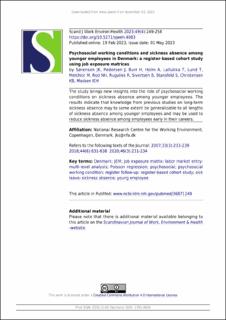Psychosocial working conditions and sickness absence among younger employees in Denmark: a register-based cohort study using job exposure matrices
| dc.contributor.author | Sørensen, Jeppe K. | |
| dc.contributor.author | Pedersen, Jacob | |
| dc.contributor.author | Burr, Hermann | |
| dc.contributor.author | Holm, Anders | |
| dc.contributor.author | Lallukka, Tea | |
| dc.contributor.author | Lund, Thomas | |
| dc.contributor.author | Melchior, Maria | |
| dc.contributor.author | Rod, Naja H. | |
| dc.contributor.author | Rugulies, Reiner | |
| dc.contributor.author | Sivertsen, Børge | |
| dc.contributor.author | Stansfeld, Stephen | |
| dc.contributor.author | Christensen, Karl B. | |
| dc.contributor.author | Madsen, Ida EH | |
| dc.date.accessioned | 2023-11-06T08:18:42Z | |
| dc.date.available | 2023-11-06T08:18:42Z | |
| dc.date.created | 2023-06-12T12:30:33Z | |
| dc.date.issued | 2023 | |
| dc.identifier.citation | Scandinavian Journal of Work, Environment and Health. 2023, 49 (4), 249-258. | en_US |
| dc.identifier.issn | 0355-3140 | |
| dc.identifier.uri | https://hdl.handle.net/11250/3100661 | |
| dc.description.abstract | Objective Previous literature has established associations between psychosocial working conditions and sickness absence (SA), but only few studies have examined associations among younger employees. This study aimed to investigate associations between psychosocial working conditions and SA among employees, aged 15–30 years, who entered the labor market in Denmark between 2010 and 2018. Method We followed 301 185 younger employees in registers for on average 2.6 years. Using job exposure matrices, we assessed job insecurity, quantitative demands, decision authority, job strain, emotional demands, and work-related physical violence. Adjusted rate ratios of SA spells of any length were estimated for women and men separately with Poisson models. Results Among women, employment in occupations with high quantitative demands, low decision authority, high job strain, high emotional demands, or high work-related physical violence was associated with higher rates of SA. Being employed in occupations with high versus low emotional demands showed the strongest association with SA, with a rate ratio of 1.44 [95% confidence interval (CI) 1.41–1.47]. Among men, being employed in occupations with low decision authority showed the strongest association with SA (1.34, 95% CI 1.31–1.37), whereas occupations with high quantitative demands, high job strain, and high emotional demands were associated with lower rates of SA. Conclusion We found that several psychosocial working conditions were associated with SA spells of any length. Associations with SA spells of any length resemble associations with long-term SA, suggesting that results from previous studies on long-term SA may be generalizable to all lengths of SA among younger employees. | en_US |
| dc.language.iso | eng | en_US |
| dc.publisher | NOROSH | en_US |
| dc.rights | Navngivelse 4.0 Internasjonal | * |
| dc.rights.uri | http://creativecommons.org/licenses/by/4.0/deed.no | * |
| dc.title | Psychosocial working conditions and sickness absence among younger employees in Denmark: a register-based cohort study using job exposure matrices | en_US |
| dc.title.alternative | Psychosocial working conditions and sickness absence among younger employees in Denmark: a register-based cohort study using job exposure matrices | en_US |
| dc.type | Peer reviewed | en_US |
| dc.type | Journal article | en_US |
| dc.description.version | publishedVersion | en_US |
| dc.source.pagenumber | 249-258 | en_US |
| dc.source.volume | 49 | en_US |
| dc.source.journal | Scandinavian Journal of Work, Environment and Health | en_US |
| dc.source.issue | 4 | en_US |
| dc.identifier.doi | 10.5271/sjweh.4083 | |
| dc.identifier.cristin | 2153753 | |
| cristin.ispublished | true | |
| cristin.fulltext | original | |
| cristin.qualitycode | 1 |
Tilhørende fil(er)
Denne innførselen finnes i følgende samling(er)
-
Institutt for psykisk helse [1312]
-
Publikasjoner fra CRIStin - NTNU [38672]

